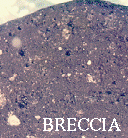All moon rocks are entirely dry. No water contained, even in chemical bonds within the rocks. All the rocks are igneous, meaning they formed entirely from molten lava. No sedimentary rocks (require water) or metamorphic rocks (requiring extreme heat and pressure).
Basalt. Basalts are found on Earth near fresh lava
flows. The rock is dark in color (that's why the maria
are dark!) and rich in heavy elements. Some basalts are vesicular.
Vesicular simply means it has bubbles
in it. The gases stay thoroughly mixed into the rock at high
pressure, but if the rock is molten near the moon surface, the
reduced pressure allows the gas bubbles to form. So we know this
rock cooled while close to or on the moon surface.
Anorthosite rocks come from the highlands on the Moon. They are the oldest known rocks on the Moon, and formed more than 4 billion years ago, when the entire moon surface was molten. They are made of lighter elements (Ca, Al, O), and literally floated to the top of the molten moon. They are very light in color and represent the true crustal rock of the moon.
 Breccia are rocks that are composed of fragments of
older rocks. Over its long history, the Moon has been
bombarded by countless meteorites. These impacts
have broken many rocks up into small fragments. The
heat and pressure of such impacts sometimes fuses
small rock fragments into new rocks, called breccias.
Breccia are rocks that are composed of fragments of
older rocks. Over its long history, the Moon has been
bombarded by countless meteorites. These impacts
have broken many rocks up into small fragments. The
heat and pressure of such impacts sometimes fuses
small rock fragments into new rocks, called breccias.
Regolith. This fine-grained material is the product of billions of years of impacts, particularly from small meteorites called micro-meteorites which sand-blast the moons surface. On earth, such objects burn up in the atmosphere and never reach the surface. The regolith is, essentially, the lunar soil, and is about 10 to 100m (30 to 300ft) thick.
The Moons Interior
The astronauts left instruments on the Moon to study seismic wave
activity. This information can be used to study the Moon's
internal structure. Most of the events observed by the seismometers
were due either to moonquakes or to meteoroid impacts. However,
the third stages of several Saturn 5 rockets and the ascent
stages of several lunar modules were deliberately crashed into
the Moon after these spacecraft were no longer needed.
These man-made crashes produced seismic events of known times
and locations and helped to calibrate the network of seismometers.
What did they find?
Like the Earth, the Moon has a crust,
mantle, and core. The lunar crust has an average thickness of 60-70
kilometers, 3 times the thickness on Earth. The lunar mantle lies
between the crust and the core. The core is composed mostly of iron
and sulfur and extends out to a radius of no more than 450 km;
less than 25% of the Moon's radius, which is quite small. The Earth's
core radius is 54% of the Earth's radius. However, the size of
the lunar core is not well constrained by existing seismic observations.